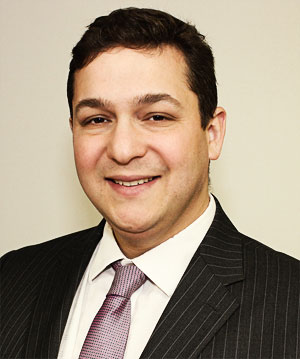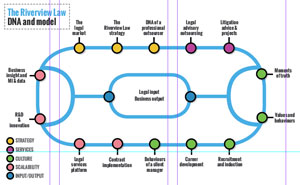Law firms are broken.
For the profession’s long-term survival, the structure of the traditional partnership — and the traditional partner and law firm management mindset that goes along with that — need to be unpended. Call it NewLaw, call it LeanLaw, call it anything but the same old, same old.
In Ontario right now there is an ongoing and fractious debate over the possibile introduction of alternative business structures — ie: non-lawyer ownership of law firms. Other provinces are also tackling the issue but chances are the initial responses in Ontario — ranging from the predominantly tepid to aggressively anti — will be mirrored elsewhere. Much is being said and written about the case for and against ABS, so when we looked at what we might do on the issue for
Canadian Lawyer, we felt perhaps we needed to reframe this discussion about the delivery of legal services in a way that wouldn’t be so polarizing but could also move it forward.
What is perfectly clear is that the traditional partnership model based on the billable hour and partner-associate leverage is not the most viable in the long run. While the economic underpinnings of the profession, as well as the economy as a whole are changing, for the most part, law firms are not.
Figures cited in the “2015 Report on the State of the Legal Market,” the survey of law firm managing partners conducted by Georgetown Law Center for the Study of the Legal Profession and Thomson Reuters Peer Monitor, show the majority of managing partners recognize there has been a fundamental shift in the legal business; the fact that less than 40 per cent say they’re going to do anything about it, is what’s truly shocking. As management consultant James Bliwas wrote in a recent article: “In other words, the overwhelming majority of managing partners can see the future clearly but are choosing to ignore it.”
While the report focuses on the U.S. market, the following statement is generally true anywhere: “[T]here is growing evidence that the market share of traditional law firms is being eroded by the presence of new competitors in the legal services sector. While the overall impact of such expanded competition remains fairly modest today, it is growing at a steady pace and, over time, promises to be even more disruptive to the near monopoly previously enjoyed by law firms in the legal services market.”
In Canada, you can count the big professional services firms in there; almost all of them offer one or more of services traditionally offered by law firms: immigration law, tax law, and document/contract review. This is not offshoring but happening in the same buildings side by side with the country’s biggest law firms. They are offering clients a full array of services, and doing it all within the confines of today’s regulatory regime. In other countries, they are being even bolder. This isn’t even talking about legal process outsourcers — which have themselves caused both upheaval and consternation for the profession in Canada — or any other type of alternative legal service providers.
Like it or not, it is happening right now. ABS or not, law firms need to start doing some long-term planning. The age of disruption is upon us.
So we invited some innovative firms at home and abroad to answer this question: With strong opposition to the idea of non-lawyer ownership of law firms, how can the traditional law firm partnership model be reimagined to make firms work better (for clients and
all their lawyers)?
In Canada, we reached out to leaders not only in firms in the corporate-commercial space — Cognition LLP — but also those aiming to serve the tens of thousands of average Canadians who might not otherwise get legal services — Axess Law — as well as small businesses and entrepreneurs — Aluvion. Riverview Law shares a perspective from the U.K., while LegalLean leader Seyfarth Shaw LLP in the U.S. tells of its model.
Read what they’re doing in the following pages. If you’re inspired or your firm is taking a new approach — either in the way it serves clients or how the firm in managed — we want to hear about it. Send your thoughts to
[email protected] or leave a comment on
canadianlawyermag.com.
Bringing law to the people
Canadian access-to-justice statistics are stark: 56 per cent of Canadian adults do not have a signed will; 70 per cent of Canadian adults do not have signed power of attorneys. In Ontario, 64 per cent of family law cases were self-represented at the time of filing and, of those who chose not to use legal professionals for their services, 90 per cent identified the perceived cost of service as the prime motivator for representing themselves. Axess Law is a law firm designed around the principle that lawyers are best suited to fill this existing service deficiency by operating in new legal service environments, most notably, at Wal-Mart locations with high foot traffic.
Prior to starting our firm, we had careers, which spanned the development of retail centres as well as the leasing of retail space and branding of small market entrants. Through this work, we became familiar with the methods and approach that other businesses adopt in retail environments. Of particular interest to us both was the big-box environment, which, at the time, was increasingly inviting smaller businesses to set up shop within their environments in an effort to supply one-stop shopping to the Canadian consumer.
By 2013, when we opened our first Wal-Mart office, it was normal for Canadians to interact with a tax preparer, a doctor, a pharmacist, a chiropractor, a dentist, and any other number of professionals within a retail store. Lawyers were the exception to this rule and, to our mind there was no good reason why that needed to be the case.
Delivering legal services within a big-box environment required us to radically change our approach to customer service. We needed to fulfil the dual mandate of large-volume retail customer service while at the same time maintaining the highest level of legal service and professionalism. This required us to adopt a strategy similar to other professionals who had successfully entered and grown their presence in the retail space. We spent many months studying other service professionals operating in the big-box environment and distilled their process into an approach that we termed Best Retail Practice.


At Axess, BRP underlies everything we do. It defines the way we built out our back-end technology, which from the start, we engineered to access client files and to use documentation generation engines over a wide geographic area. BRP also keeps us focused on areas of law with defined workflows, which require a near complete transactional understanding of a client’s needs in advance of a meeting. If implemented properly, BRP means we can determine the duration and price of a given client meeting in advance of an appointment — a crucial aspect of any retail operation.
Beyond technology, BRP means incorporating business hours not traditionally seen in law firms: Axess is open seven days a week and until 8 p.m. on weekdays. We believe in a fully transparent pricing model where costs are clearly set out at the beginning of the process and we adhere to open concept environments, while maintaining respect for proper solicitor-client privilege.
Most of all, Axess Law’s BRP approach is based around the idea that small transactions, done in volume, net powerful results. Wal-Mart itself grew into one of the world’s largest corporations through small transactions performed in volume and in the process expanded the reach and ability of North Americans to better afford mass consumer goods. At Axess Law, we believe in the same principle. In many cases, we are targeting the segment of people who are not using lawyers and in so doing, we are providing legal services to those people who, absent a firm like Axess Law, would not gain access to such services from a competent professional.
We believe that Axess Law is a new and exciting approach to the way law is practised and we firmly believe there is no reason why we need to be alone in servicing Canadians this way. Retail is a part of Canadian life and services are delivered in retail environments all the time. Embracing this opportunity is not only a good business opportunity it answers the demand Canadians are making on our profession every day. We see opportunity in this market and think our profession should too. The opportunities are significant and the mandate we fulfil, providing Canadians with access to justice, is a critical one.
Mark Morris and Lena Koke are the co-founders of Axess Law PC, a consumer-focused law firm specializing in real estate, wills, power of attorneys, business registrations, and notary services. Axess has five offices (and more on the way) located inside Wal-Mart stores in the Greater Toronto Area.
Creating new land from the old
At Aluvion, we think differently about technology, people, and process. About how we can improve the client experience and deliver great value to our clients, while enabling a better work-life balance for everyone on our team. Simply stated, we think business law needs a facelift.
Our name — Aluvion — is derived from alluvium, legalese for the process of creating new land from the old. It intentionally evokes a creative, accretive process. At our core, we are still a law firm.
But we are re-imagining how business law services are being created for and consumed by clients, just as other innovators are working in other legal disciplines.
All of the founders of Aluvion — Eric Apps, Michael Berger, and myself — have backgrounds in law, business, and technology.
Law is a second career, my first was as an engineer. Lawyers and engineers are both problem solvers with the fundamental difference that one looks to the past to solve problems of today, and the other looks to solve the problems of the future. I thought once I entered the practice of law, I would be leaving my engineering background behind, but the engineering problem solver saw and continues to see tremendous opportunities to the process of how legal work is done.
When people speak of the “broken” legal model, most people inside and outside the profession are thinking and talking mostly about money. Many business lawyers have not accepted that firms will all be making less of it moving forward. Margin erosion, commoditization, competition, however you think of it. At Aluvion, we have embraced that. We are responding in a positive way and focusing on two key areas: using technology innovation to make the “time is money” equation work better for lawyers as well, and also providing a very different day-to-day work experience and work-life balance for our team.
Our firm’s tagline is “doing legal differently.” We think it summarizes our core mission and value proposition.
It also seems to attract a lot of attention. The question I often get is “how exactly are you doing legal differently?”

There are a few things we can point to that are core to our business:
Technology: We have embraced a cloud-based platform and have automated significant areas of business legal services that are currently costly and manually intensive.
Client relationships: The time-based billing model is dying; legal services are being commoditized. We are focused on removing unnecessary costs from legal processes, while maintaining high levels of quality, consistency, reliability, and client interaction.
People: Aluvion has created a space for legal professionals to work together in a multidisciplinary team to serve the needs of our clients, and also to have a lot of laughs along the way. We want everyone to feel and behave “like a partner” from day one, and that includes sharing in the benefits of our success — a very different message from the traditional “up or out” model of law firms.
We are just getting started at Aluvion, but we have already had a positive reception from clients and from other lawyers. We are optimistic about what we will accomplish.
Monica Goyal is a founder of Aluvion. She holds an MS in engineering from Stanford University and a JD from the University of Toronto. She also teaches a course on legal information technology at Osgoode Hall Law School and was named one of 10 women to watch in legal tech by the ABA Journal.
Incredible opportunities await the brave
For those of you familiar with the strong-tasting British product of the same name, you’ll understand why I say the ABS debate in North America has elicited a “Marmite” response, which splits the audience into two opposing but equally passionate camps. Love it or hate it, in this global economy in which liberalization of legal service regulation can be seen across several continents, it’s a trend that’s likely to find its way over here sooner or later. In the meantime, imagine what could be achieved if that same zeal were to be applied to constructive change efforts in the present!
ABS is merely one proposed solution to the underlying problems that have inevitably arisen over time in a self-regulated and protected industry — restrictive practices, competition issues, insufficient accountability, lack of transparency, poor business service, insufficient regard to the interests of consumers, etc. These phrases are all to be found in the U.K. government’s pre-Legal Services Act review, and seem largely echoed by the broader European agencies that made liberalization a condition of bailouts and have gone so far as to ask whether lawyers really need vertical regulation at all.
Viewed through a different lens, perhaps the greatest threat to traditional law firms comes not from the outside, but from within: resistance to change. With little pressure from external market forces, the predominant risk-averse personality type has managed to prevent any substantive change for decades. That gap now needs to be bridged, and at a time such as this (liberalized regulation is nothing compared to what’s on the technology horizon) it’s never been more important to maintain an open mind, ask the difficult questions, and dare to act on the answers.

For example: If building our law firm from scratch today, what should it look like? What if it had to compete with accounting firms and other new entrants in a liberalized framework? Are we riding the wave of emerging technologies or about to be drowned by them? What values and culture do we seek to promote and how successful are we? How much does our current operating model revolve around us versus our customers? Is efficiency the enemy of our model or the friend? What behaviours do our billing mechanisms drive internally and externally? Are we investing properly for the medium-to-long term?
Changes to the regulatory framework may be a catalyst for change, but they’re certainly not a prerequisite for it. At Riverview Law, we picked up numerous awards and were dubbed “the most innovative law firm in the world” by more than one market commentator long before we secured our ABS licence. Our DNA and non-partnership model (see diagram) are wholly intentional, carefully constructed, and highly protected, but what we’re doing isn’t rocket science — although given some of our recent breakthroughs in artificial intelligence, we may not be able to say that for much longer!

In Canada, pioneers like Conduit, Cognition, and Axess are already demonstrating the art of the possible for law firms operating within the current regulatory constraints. South of the border, others are doing the same. Even Big Law are getting in on the action, as this recent quote from the chairman of a large successful firm shows: “We’ve given ourselves five years to reinvent the firm by changing our business model — no more tweaking and pretending. There’ll be pain. And that’s a good thing.”
In the immortal words of Coldplay, “nobody said it was easy!” In fact, if Harvard’s professor Clayton Christensen is right, his research on disruptive innovation suggests that it’s almost impossible to turn the proverbial oil tanker with its embedded resources, processes, and priorities, and sometimes easier to let down a lifeboat and start afresh with an alternative entity that’s free from the legacy constraints of the mother ship. Certainly that’s the route an increasing number of traditional U.K. firms seem to be going, such as BLP’s Lawyers on Demand, Eversheds’ Agile, and Pinsent Masons’ Vario.
One thing is clear, though. Our industry will see unparalleled change in the next decade or so, and there are incredible opportunities for those who choose to embrace it rather than bury their heads in the sands of the profession. As John F. Kennedy once remarked, “Change is the law of life. And those who look only to the past or present are certain to miss the future.”
Andy Daws is the vice president, North America, of Riverview Law. Built from the ground up and launched in the United Kingdom only three years ago, Riverview Law looks unlike any other law firm and aims to change the way businesses buy, use, and measure legal services. For more on Riverview Law read the Harvard Business School case study: “Riverview Law – Applying Business Sense to the Legal Market.”
Pioneers of #LegalLean service delivery
Law firms can drive innovation and expand technology use in legal service delivery within existing regulatory schemes. Seyfarth Shaw LLP has pioneered legal service delivery initiatives through the law firm since starting its SeyfarthLean journey in 2005, and through its SeyfarthLean Consulting LLC subsidiary since 2008.
By 2005, it had become clear to Seyfarth that clients were interested in legal service delivery models that included more than what law firms traditionally offered. As the SeyfarthLean model evolved, the firm saw three ways in which it could use the model to help clients.
First, when retained to provide legal services, the firm could deliver them more efficiently through a lean model. Using lean approaches in three areas — process, platform, and people — Seyfarth could customize its service delivery. Second, there were times when clients wanted assistance through lean tools but did not need traditional legal services coupled with those tools. These consulting projects covered a broad range of matters, such as project managing an IPO, assisting with managing and analyzing a law firm convergence initiative, and developing contract processing procedures. Third, there were times when clients wanted both legal and consulting services. For example, improving a contract process, and want Seyfarth to handle review for some of the contracts.
Initially, everything was offered through the law firm. But, as client demand for the services grew, the firm saw a better model. SeyfarthLean Consulting LLC became the vehicle for consulting services and software licensing. As a wholly owned subsidiary of Seyfarth, SeyfarthLean Consulting benefits from the connection to the parent law firm. As a separate legal entity, it can take on projects similar to what an independent consulting firm would provide. The separation of businesses provides advantages for both the law firm and clients.
From the client perspective, there are times when clients want the SeyfarthLean knowledge and experience, but do not want to tackle the challenges of bringing another law firm on board. The separate structure also can assist a client when the hiring person is outside the law department, such as in human resources. Since the client is hiring a consulting firm, not a law firm, the hiring party can go directly to SeyfarthLean Consulting rather than through its law department.
From the law firm’s perspective, having a consulting subsidiary allows the business to operate on a model competitive with other consultants and vendors. Consulting firms operate in an environment with different pricing, risk profiles, conflict of interest parameters, and compensation arrangements. As Seyfarth develops software packages, it makes business sense to license them through the consultancy rather than try to graft a licensing model on to a law firm model. Trying to compete outside the legal services environment with a law firm business model would introduce some unusual constraints.

Today, the SeyfarthLean Consulting model continues to evolve as clients become more familiar with what it offers. It has more than 30 client-facing individuals providing services in areas not traditionally found in law firms, including consultants, technologists, project managers, business strategists, data analytics specialists, and process improvement professionals. For each engagement, SeyfarthLean Consulting assembles an interdisciplinary team that approaches the client’s problem using diverse domain knowledge and skill sets. To those broad capabilities, it adds an extensive background in customized technology solutions to help clients resolve problems and find ways to prevent them from recurring, delivering them through one integrated platform combining best-in-class technologies mapped to specific needs of legal organizations.
The two-pronged approach of Seyfarth Shaw LLP and SeyfarthLean Consulting LLC enables the firm to focus on what clients need and provide resources to meet those needs, while at the same time building a growth vehicle that offers opportunities beyond the traditional structure of a law firm.
Making changes to how you deliver legal services at first seems daunting. I had been successful following the traditional path of legal service delivery, first in law firms and then as an in-house counsel. But, as I looked at what I was doing and how I was doing it, I could see that much of what I was doing did not add value. As an in-house lawyer, I felt this acutely. I wasn’t paid for more effort; I was paid to add value.
As I eliminated those things that took time, but didn’t add value, several things happened. My days became less stressful and more interesting. I was solving problems, not pushing paper. The number of fire drills went down and the amount of strategic listening and coaching went up. My time with clients became more about how to move the business forward, than move the document forward.
I have worked with lawyers in firms who saw the same thing happen, when they coupled their changes with value-based fees. They found themselves returning to the role of counselor from the job of fire marshal. Instead of battles over fees, they had planning sessions that built frameworks for solving client problems. While changing was difficult, getting back to what I wanted to really do as a lawyer made it worthwhile.
Kenneth A. Grady is a lean law evangelist for Chicago-based Seyfarth Shaw LLP. He works with lawyers and law departments to help them see where the firm’s SeyfarthLean approach, which uses combinations of processes, platforms, and people, can drive superior legal service delivery.
Creating a third option
Cognition turned 10 years old in March, and while we are a strong proponent of alternative business structures, it is worth reflecting on what we have achieved and plan to accomplish in its absence.
Our goal from inception was to create a “third option” for businesses and corporate counsel beyond hiring in-house counsel or using a traditional business law firm to effect legal needs.
Particularly as insourcing has flourished, as has the resulting scope of in-house work, there had to be a better and more cost-effective, next-best way to bringing as much as possible inside.
Thus the creation and evolution of Cognition — the first law firm comprised of senior in-house counsel who also brought the peace of mind of previous Bay Street experience and success. Best of breed as we like to call it. And by inserting those people into a structure built from the ground up where we scrutinize every expenditure and utilize software-as-a-service-based technology for optimum efficiency, our hundreds of clients have received the services of better-suited people at less than half the cost of comparable traditional firm resources. Tough to object to that.
When we started our model, we decided to structure as a law firm and have stayed that way. ABS was not on the radar and a corporate structure seemed too foreign for our purposes, not to mention the comfort of even our early adopter clients. However, we refused to allow our business structure to determine our method of operations. Rather than merely emulating the traditional law firm structure and operating mode, we started with a blank slate to create the ideal legal services organization from both client and lawyer perspectives.
More specifically, here are some of the unique ways we painted our picture:
•
separate owner from personnel; line from staff — Not all lawyers have to be owners, nor should they feel that they have to be one in order to be successful and enriched in their careers. We believe in specialization; our lawyers should focus on delivering legal services, our owners should navigate the vision and strategy for the business, and our business personnel should perform roles such as sales, client happiness, lawyer happiness, financial planning, and the like. We currently have three owners, approximately 50 lawyers, and a business head office of about 10 staff.
•
cut overhead and at the same time get closer to clients — Maintaining a minimalist business head office creates an open environment that is great for culture and collaboration, while placing our lawyers closer to and even embedded with clients. That makes us a more client-centric, operationally knowledgeable law firm — exactly what corporate counsel say they want.
•
only charge for experienced lawyers — When I ran a legal department, I could never get over seeing training on my bill. That’s why we only deploy experienced counsel for charge, making the multiplier on cost efficiency and savings even greater for the client than just our comparable pricing differential.
•
only bill once — If using time as a billing metric, no more than one person can bill for a given task. Otherwise, there’s learning being charged to the client.

•
never charge for internal expenses, including travel time — Should be obvious by now. But it isn’t. If clients want us to visit them or be with them in their operations, that means they want us closer to them. Why would we charge them for that?
•
charge by the work not by person — We attach fees to the type of work being done, which are the same regardless of who does the work. Whoever does it will meet our best-of-breed standards, so why charge more based on age?
And here’s what’s new to the fold:
•
value-based billing — We have just launched the first objective, scorecard-based billing system where clients can automatically alter the amount of their invoice by assessing our work according to six value-based criteria.
•
“Productizing” business law — We believe the future lies in transforming
ad hoc services into permanent solutions and in using technology, experience, and ingenuity to do so. We have already launched related business lines around law department consulting (given our unparalleled general counsel experience within a firm environment), technology advisory and concierge, contract and document management systems, and project organization. Products like this also have the benefit of being run out of separate business entities even in the absence of ABS.
Let’s be clear, ABS is a worthy initiative. However as demonstrated by our record to date, while the absence of non-lawyer ownership will be an obstacle, it will not deter our success.
Joe Milstone is co-founder of Cognition LLP. Giving its clients the best of both worlds, Cognition’s model provides senior, business-minded legal advice at affordable rates, under flexible structures, and with counsel possessing a unique blend of private practice and in-house experience. He began his working career at Oslers and later was VP, legal, at both Call-Net Enterprises Inc. (Sprint Canada) and Magna Entertainment Corp.


 At Axess, BRP underlies everything we do. It defines the way we built out our back-end technology, which from the start, we engineered to access client files and to use documentation generation engines over a wide geographic area. BRP also keeps us focused on areas of law with defined workflows, which require a near complete transactional understanding of a client’s needs in advance of a meeting. If implemented properly, BRP means we can determine the duration and price of a given client meeting in advance of an appointment — a crucial aspect of any retail operation.
At Axess, BRP underlies everything we do. It defines the way we built out our back-end technology, which from the start, we engineered to access client files and to use documentation generation engines over a wide geographic area. BRP also keeps us focused on areas of law with defined workflows, which require a near complete transactional understanding of a client’s needs in advance of a meeting. If implemented properly, BRP means we can determine the duration and price of a given client meeting in advance of an appointment — a crucial aspect of any retail operation.
 For example: If building our law firm from scratch today, what should it look like? What if it had to compete with accounting firms and other new entrants in a liberalized framework? Are we riding the wave of emerging technologies or about to be drowned by them? What values and culture do we seek to promote and how successful are we? How much does our current operating model revolve around us versus our customers? Is efficiency the enemy of our model or the friend? What behaviours do our billing mechanisms drive internally and externally? Are we investing properly for the medium-to-long term?
For example: If building our law firm from scratch today, what should it look like? What if it had to compete with accounting firms and other new entrants in a liberalized framework? Are we riding the wave of emerging technologies or about to be drowned by them? What values and culture do we seek to promote and how successful are we? How much does our current operating model revolve around us versus our customers? Is efficiency the enemy of our model or the friend? What behaviours do our billing mechanisms drive internally and externally? Are we investing properly for the medium-to-long term?

